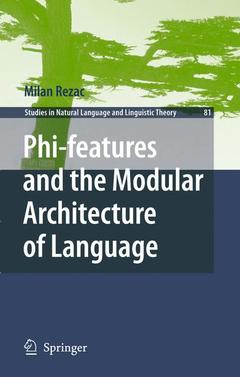Acknowledgments.-Conventions and glosses.-Preface.-1 Modularity, phi-features, and repairs.-1.1 Introduction. 1.2 Modular architectures.1.3 Phi-features across modules.1.4 Repairs at the interface.-2 Phi-features in realizational morphology.2.1 Modularity, morphology, and phi-features.2.2 Opaque cliticization and agreement. 2.3 Gaps and synthetic-analytic alternations.2.4 The limits of a modular signature.-3 Person Hierarchy interactions in syntax.3.1 Person hierarchies and PH-interactions.3.2 PH-interactions in Ojibwa and Mapudungun. 3.3 Theories of PH-interactions.3.4 PH-interactions and repairs in Tanoan.3.5 The limits of syntactic PH-interactions.-4 Person Case Constraint repairs in French.4.1 Introduction.4.2 French clitics.4.3 The PCC repair and the Cliticization Requirement.4.4 The syntactic character of the repair.4.4.1 Introduction.4.4.2 Floating quantifiers.4.4.3 Condition B.4.4.4 Right dislocation.4.4.5 Phi-agreement.4.4.6 Overview.4.5 Applicative datives.4.5.1 Introduction.4.5.2 Possessive, dessus, and benefactive datives.4.5.3 Causee datives.4.5.4 Connaître-class causee datives.4.5.5 Experiencer datives.4.5.6 Overview.4.6 Irreparable problems.4.6.1 Introduction.4.6.2 Multiple dative clitics.4.6.3 Arbitrary clitic cluster gaps.4.6.4 Mediopassive se + dative clitic.4.6.5 Datives in DPs and APs.4.6.6 Coordination and modification.4.6.7 Datives in causatives.4.6.8 The weak PCC.4.6.9 Overview.4.7 The PCC, the repairs, and the nature of datives.4.8 Appendix A: Exceptional Case Marking.4.9 Appendix B: Datives in PCC contexts.-5 Repairs and uninterpretable features.5.1 Introduction.5.2 The Person Case Constraint.5.2.1 The Agree/Case approach.5.2.2 Intervention.5.2.3 Agreement, Case, Licensing.5.2.4 Datives.5.2.5 Overview.5.3 The repairs of the Person Case Constraint.5.3.1 The character of the repairs.5.3.2 The choice of mechanisms.5.3.3 Global mechanisms.5.4 The Minimalist Program: uninterpretability, interfaces, and repairs.5.4.1 Uninterpretable features: phi, Case, and Agree.5.4.2 The interface algorithm .5.4.3 Phase theory.5.5 Dependent Case as last-resort.5.6 Unaccusative repairs: Transitivization.5.6.1 Introduction.5.6.2 Basque.5.6.3 Chinook.5.6.4 Finnish.5.6.5 Overview.5.7 Transitive repairs: Strengthening the PP.5.8 Transitive repairs: Strengthening the DP.5.9 Conclusion: The scope and limits of Aspects of .5.9.2 Person and Case licensing.5.9.3 Licensing, Full Interpretation, and .-6 Phi in syntax and phi interpretation.6.1 Phi-alphabets.6.2 Syntactic and intepretive phi-mismatches.6.3 French on.6.4 Person in syntax.6.5 Person in interpretation.6.6.- Conclusion.-Name and Subject index




